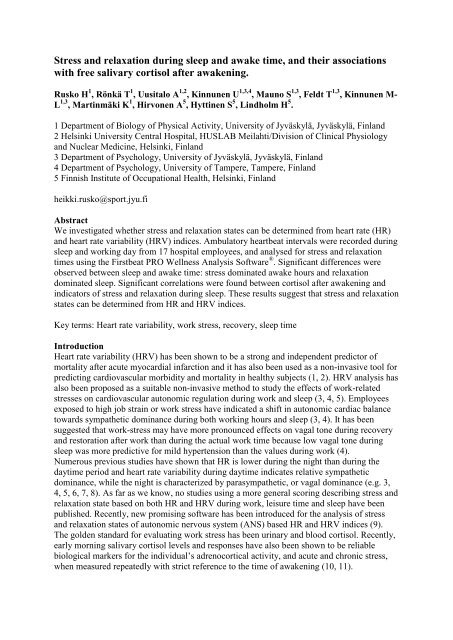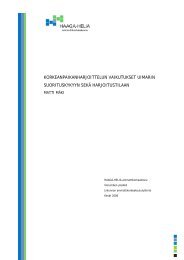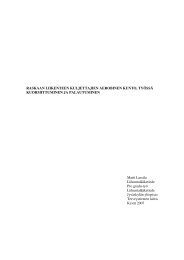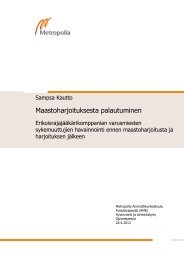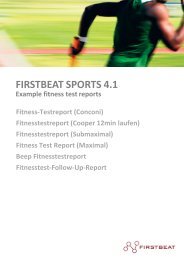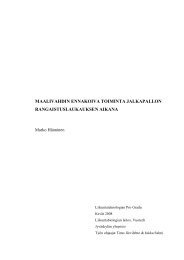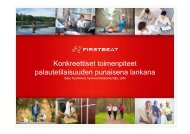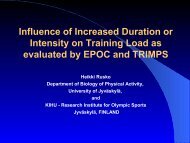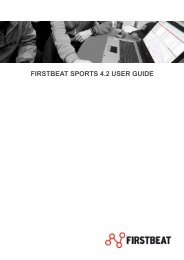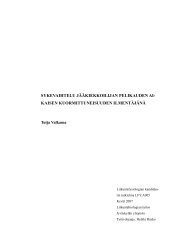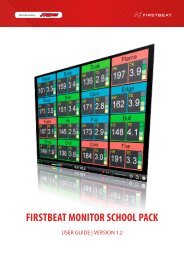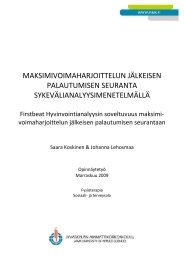Stress and relaxation during sleep and awake time, and ... - Firstbeat
Stress and relaxation during sleep and awake time, and ... - Firstbeat
Stress and relaxation during sleep and awake time, and ... - Firstbeat
You also want an ePaper? Increase the reach of your titles
YUMPU automatically turns print PDFs into web optimized ePapers that Google loves.
<strong>Stress</strong> <strong>and</strong> <strong>relaxation</strong> <strong>during</strong> <strong>sleep</strong> <strong>and</strong> <strong>awake</strong> <strong>time</strong>, <strong>and</strong> their associationswith free salivary cortisol after <strong>awake</strong>ning.Rusko H 1 , Rönkä T 1 , Uusitalo A 1,2 , Kinnunen U 1,3,4 , Mauno S 1,3 , Feldt T 1,3 , Kinnunen M-L 1,3 , Martinmäki K 1 , Hirvonen A 5 , Hyttinen S 5 , Lindholm H 5 .1 Department of Biology of Physical Activity, University of Jyväskylä, Jyväskylä, Finl<strong>and</strong>2 Helsinki University Central Hospital, HUSLAB Meilahti/Division of Clinical Physiology<strong>and</strong> Nuclear Medicine, Helsinki, Finl<strong>and</strong>3 Department of Psychology, University of Jyväskylä, Jyväskylä, Finl<strong>and</strong>4 Department of Psychology, University of Tampere, Tampere, Finl<strong>and</strong>5 Finnish Institute of Occupational Health, Helsinki, Finl<strong>and</strong>heikki.rusko@sport.jyu.fiAbstractWe investigated whether stress <strong>and</strong> <strong>relaxation</strong> states can be determined from heart rate (HR)<strong>and</strong> heart rate variability (HRV) indices. Ambulatory heartbeat intervals were recorded <strong>during</strong><strong>sleep</strong> <strong>and</strong> working day from 17 hospital employees, <strong>and</strong> analysed for stress <strong>and</strong> <strong>relaxation</strong><strong>time</strong>s using the <strong>Firstbeat</strong> PRO Wellness Analysis Software ® . Significant differences wereobserved between <strong>sleep</strong> <strong>and</strong> <strong>awake</strong> <strong>time</strong>: stress dominated <strong>awake</strong> hours <strong>and</strong> <strong>relaxation</strong>dominated <strong>sleep</strong>. Significant correlations were found between cortisol after <strong>awake</strong>ning <strong>and</strong>indicators of stress <strong>and</strong> <strong>relaxation</strong> <strong>during</strong> <strong>sleep</strong>. These results suggest that stress <strong>and</strong> <strong>relaxation</strong>states can be determined from HR <strong>and</strong> HRV indices.Key terms: Heart rate variability, work stress, recovery, <strong>sleep</strong> <strong>time</strong>IntroductionHeart rate variability (HRV) has been shown to be a strong <strong>and</strong> independent predictor ofmortality after acute myocardial infarction <strong>and</strong> it has also been used as a non-invasive tool forpredicting cardiovascular morbidity <strong>and</strong> mortality in healthy subjects (1, 2). HRV analysis hasalso been proposed as a suitable non-invasive method to study the effects of work-relatedstresses on cardiovascular autonomic regulation <strong>during</strong> work <strong>and</strong> <strong>sleep</strong> (3, 4, 5). Employeesexposed to high job strain or work stress have indicated a shift in autonomic cardiac balancetowards sympathetic dominance <strong>during</strong> both working hours <strong>and</strong> <strong>sleep</strong> (3, 4). It has beensuggested that work-stress may have more pronounced effects on vagal tone <strong>during</strong> recovery<strong>and</strong> restoration after work than <strong>during</strong> the actual work <strong>time</strong> because low vagal tone <strong>during</strong><strong>sleep</strong> was more predictive for mild hypertension than the values <strong>during</strong> work (4).Numerous previous studies have shown that HR is lower <strong>during</strong> the night than <strong>during</strong> theday<strong>time</strong> period <strong>and</strong> heart rate variability <strong>during</strong> day<strong>time</strong> indicates relative sympatheticdominance, while the night is characterized by parasympathetic, or vagal dominance (e.g. 3,4, 5, 6, 7, 8). As far as we know, no studies using a more general scoring describing stress <strong>and</strong><strong>relaxation</strong> state based on both HR <strong>and</strong> HRV <strong>during</strong> work, leisure <strong>time</strong> <strong>and</strong> <strong>sleep</strong> have beenpublished. Recently, new promising software has been introduced for the analysis of stress<strong>and</strong> <strong>relaxation</strong> states of autonomic nervous system (ANS) based HR <strong>and</strong> HRV indices (9).The golden st<strong>and</strong>ard for evaluating work stress has been urinary <strong>and</strong> blood cortisol. Recently,early morning salivary cortisol levels <strong>and</strong> responses have also been shown to be reliablebiological markers for the individual’s adrenocortical activity, <strong>and</strong> acute <strong>and</strong> chronic stress,when measured repeatedly with strict reference to the <strong>time</strong> of <strong>awake</strong>ning (10, 11).
ObjectivesWe investigated whether stress <strong>and</strong> <strong>relaxation</strong> states can be determined from heart rate (HR)<strong>and</strong> heart rate variability (HRV) indices using the <strong>Firstbeat</strong> PRO Wellness AnalysisSoftware ® . More specifically the research problems were as follows: 1) are there differencesin stress <strong>and</strong> <strong>relaxation</strong> <strong>time</strong>s between <strong>sleep</strong> <strong>and</strong> <strong>awake</strong> <strong>time</strong> in healthy hospital workers, <strong>and</strong>2) are there differences between workers in stress <strong>and</strong> <strong>relaxation</strong> <strong>time</strong>s <strong>during</strong> <strong>sleep</strong> <strong>and</strong><strong>awake</strong> <strong>time</strong> <strong>and</strong> are these differences related to salivary cortisol variables after <strong>awake</strong>ning.MethodsThis study is part of the “Heart Rate <strong>and</strong> Work <strong>Stress</strong>” research project at the University ofJyväskylä. The subjects of the present study were 17 employees (16 nurses, one physician)from the Central Hospital of Central Finl<strong>and</strong>. In the present study 24-h ambulatory R-to-Rinterval (RRI) data <strong>and</strong> <strong>awake</strong>ning salivary cortisol data were collected at the end of theworking week. Five subjects from the original sample of 22 were rejected due to diseasesinfluencing RRI-data or error percentage of RRI recordings. Average age of the employeeswas 42 years ranging from 24 to 57 years.Variables describing stress <strong>and</strong> <strong>relaxation</strong> <strong>during</strong> <strong>sleep</strong> <strong>and</strong> <strong>awake</strong> <strong>time</strong> were determinedfrom 24-h ambulatory RRI data based on Heart Rate (HR) <strong>and</strong> Heart Rate Variability (HRV)indices using <strong>Firstbeat</strong> PRO Wellness Analysis Software ® (WAS) version 1.4.1 (9). Theanalysis of stress <strong>and</strong> <strong>relaxation</strong> is based on the detection of sympathovagal reactivity thatexceeds momentary metabolic requirements for the autonomic nervous system. The programcalculates HRV indices second-by-second using the short-<strong>time</strong> Fourier Transform method(STFT), <strong>and</strong> HR- <strong>and</strong> HRV-derived variables that describe respiration rate <strong>and</strong> oxygenconsumption (VO2) using neural network modeling of data (12, 13, 14, 15). The program alsocalculates second-by-second indices of stress <strong>and</strong> <strong>relaxation</strong>, reflecting activity of thesympathetic (absolute stress vector, ASV) <strong>and</strong> parasympathetic (absolute <strong>relaxation</strong> vector,ARV) nervous system. ASV is calculated from HR, high frequency power (HFP), lowfrequency power (LFP) <strong>and</strong> HRV-derived respiratory variables. ASV is high when heart rateis elevated, HRV is reduced <strong>and</strong> respiration rate is low relative to HR <strong>and</strong> HRV. ARV iscalculated from HR <strong>and</strong> HFP <strong>and</strong> it is high when HR is close to the basic resting level <strong>and</strong>HRV is great <strong>and</strong> regular (9, 13). From the above variables the program draws conclusions onthe duration of different physiological states of the body <strong>during</strong> night <strong>sleep</strong> <strong>and</strong> working dayby segmenting the data into stationary segments. The data segments, including movement,physical activity at different intensities <strong>and</strong> recovery from physical activity, are detected usingHR, HRV-derived respiration rate, estimated VO2 <strong>and</strong> movement-related ANS responses. Fornon-exercise data segments, the <strong>time</strong> when the body is in a stress state (<strong>Stress</strong> <strong>time</strong>),<strong>relaxation</strong> state (Relaxation <strong>time</strong>) or an unrecognized state is determined. The stress state isdefined as an increased activation in the body, induced by external <strong>and</strong> internal stress factors(stressors), <strong>during</strong> which sympathetic nervous system activity is dominating <strong>and</strong>parasympathetic (vagal) activation is decreased. This definition does not take into account thenature of the stress response, that is, whether it is positive or negative. The <strong>relaxation</strong> state isdefined as a decreased activation in the body <strong>during</strong> <strong>relaxation</strong>, rest <strong>and</strong>/or peaceful working,related to the lack of external <strong>and</strong> internal stress factors when parasympathetic activation isdominating. In the present study, stress <strong>and</strong> <strong>relaxation</strong> <strong>time</strong>s were calculated separately for the<strong>sleep</strong> <strong>time</strong> <strong>and</strong> for the <strong>awake</strong> hours including work <strong>and</strong> leisure <strong>time</strong>.Awakening cortisol level (AC 0 ) <strong>and</strong> 30-min cortisol <strong>awake</strong>ning response (CAR 30 = differencebetween AC 30 <strong>and</strong> AC 0 ) were analyzed from saliva samples taken immediately after <strong>and</strong> 30-min after <strong>awake</strong>ning according to Pruessner et al. (10). Free salivary cortisol was analyzedusing chemiluminescence detection (IBL Hamburg: Cortisol Saliva LIA RE62011).
ResultsSignificant differences were found in all variables between <strong>sleep</strong> <strong>and</strong> <strong>awake</strong> <strong>time</strong>, Table 1.Table 1. Mean, st<strong>and</strong>ard deviation (SD) <strong>and</strong> range of total <strong>time</strong>, stress <strong>time</strong> <strong>and</strong> percentage,<strong>relaxation</strong> <strong>time</strong> <strong>and</strong> percentage, <strong>and</strong> average heart rate <strong>during</strong> <strong>awake</strong> hours <strong>and</strong> <strong>sleep</strong> (n=17).AwakeSleepPMean ± SD(range)Mean ± SD(range)Total <strong>time</strong> 1013 ± 39438 ± 51
<strong>Stress</strong> dominated <strong>awake</strong> hours <strong>and</strong> <strong>relaxation</strong> dominated <strong>sleep</strong> as could be expected accordingto the previous studies. Wide variation between subjects was observed in stress <strong>and</strong> <strong>relaxation</strong><strong>time</strong>s <strong>during</strong> both <strong>awake</strong> hours <strong>and</strong> <strong>sleep</strong>. The correlations between cortisol variables after<strong>awake</strong>ning <strong>and</strong> indicators of stress <strong>and</strong> <strong>relaxation</strong> <strong>during</strong> <strong>sleep</strong> suggest that ANS functionbased recovery <strong>during</strong> <strong>sleep</strong> may influence cortisol <strong>awake</strong>ning response. Finally, the resultssuggest that stress <strong>and</strong> <strong>relaxation</strong> states based on HR <strong>and</strong> HRV can be used for investigatingthe effects of work stress <strong>during</strong> both <strong>awake</strong> <strong>time</strong> <strong>and</strong> <strong>sleep</strong>.References1. Dekker JM, Schouten EG, Klootwijk P, Pool J, Swenne CA, Kromhout D. Heart ratevariability from short electrocardiographic recordings predicts mortality from all causes inmiddle-aged <strong>and</strong> elderly men. The Zutphen Study. Am J Epidemiol 1997; 145: 899-908.2. Huikuri HV, Makikallio TH, Airaksinen KE, Seppanen T, Puukka P, Raiha IJ, Sour<strong>and</strong>erLB. Power-law relationship of heart rate variability as a predictor of mortality in the elderly.Circulation 1998; 97: 2031-363. Amelsvoort LGPM, Schouten EG, Maan AC, Swenne CA, Kok FJ. Occupationaldeterminants of heart rate variability. Int Arch Occup Environ Health 2000; 73: 255-62.4. Vrijkotte TGM, van Doornen LJP, de Geus EJC. Effects of Work <strong>Stress</strong> on AmbulatoryBlood Pressure, Heart Rate, <strong>and</strong> Heart Rate Variability. Hypertension. 2000; 35: 880-6.5. Collins S, Karasek R, Kostas K. Job strain <strong>and</strong> autonomic indices of cardiovascular diseaserisk. Am J Ind Med 2005; 48: 182 - 193.6. Furlan R, Guzzetti S, Crivellaro W, Dassi S, Tinelli M, Baselli G, Cerutti S, Lombardi F,Pagani M, Malliani A. Continuous 24-hours assessment of the neural regulation of systemicarterial pressure <strong>and</strong> R-R variabilities in ambulant subjects. Circulation, 1990; 81: 537-47.7. Monti A, Medigue C, Nedelcoux H, Escourrou P. Autonomic control of the cardiovascularsystem <strong>during</strong> <strong>sleep</strong> in normal subjects. Eur J Appl Physiol 2002; 87: 174-81.8. Carrington M, Walsh M, Stambas T, Kleiman J, Trinder J. The influence of <strong>sleep</strong> onset onthe diurnal variation in cardiac activity <strong>and</strong> cardiac control. J. Sleep Res. 2003; 12: 213-21.9. <strong>Firstbeat</strong> PRO Wellness Analysis Software, 2005. Available from (http://www.firstbeat.fi).10. Pruessner JC, Wolf OT, Hellhammer DH, Buske-Kirschbaum A, von Auer K, Jobst S,Kaspers F, Kirschbaum C. Free cortisol levels after <strong>awake</strong>ning: a reliable biological markerfor the assessment of adrenocortical activity. Life Sci. 1997;61(26):2539-49.11. Pruessner JC, Hellhammer DH, Kirschbaum C. Burnout, perceived stress, <strong>and</strong> cortisolresponses to <strong>awake</strong>ning. Psychosom Med. 1999; 61:197-204.12. Saalasti S. Neural networks for heart rate <strong>time</strong> series analysis. Ph.D. Dissertation.Department of Mathematical Information Technology, University of Jyväskylä, Finl<strong>and</strong>.Jyväskylä Studies in Computing 33, University of Jyväskylä, Jyväskylä; 2003.13. Kettunen J, Saalasti S. Procedure for detection of stress by segmentation <strong>and</strong> analyzingheart beat signal, 2004. Pat. No WO 2004/016172 A1.14. Kettunen J, Saalasti S. Procedure for deriving reliable information on respiratory activityfrom heart period measurement, 2005. United States Patent Application 20050209521.15. <strong>Firstbeat</strong> Technologies. VO2 Estimation Method Based on Heart Rate Measurement,2005. Available from: http://www.firstbeat.fi/files/VO2_Estimation.pdf16. Backhaus J, Junghanns K, Hohagen F. Sleep disturbances are correlated with decreasedmorning <strong>awake</strong>ning salivary cortisol. Psychoneuroendocrinology 2004; 29:1184-91.
1. Preference of the presentation: oral2. Preference for the theme: Physical, mental <strong>and</strong> social well-being3. Contact information:Heikki Rusko, Ph.D., ProfessorDepartment of Biology of Physical Activity, University of JyväskyläJyväskylä, Finl<strong>and</strong>Email: heikki.rusko@sport.jyu.fiPhone: +358142603112; +358142603172Mobile phone: +358400641596Fax: +358142602011Postal Address: P.O.Box 35 (LL), 40014 University of Jyväskylä, Finl<strong>and</strong>Street Address: Rautpohjankatu 8, 40700 Jyväskylä, Finl<strong>and</strong>


